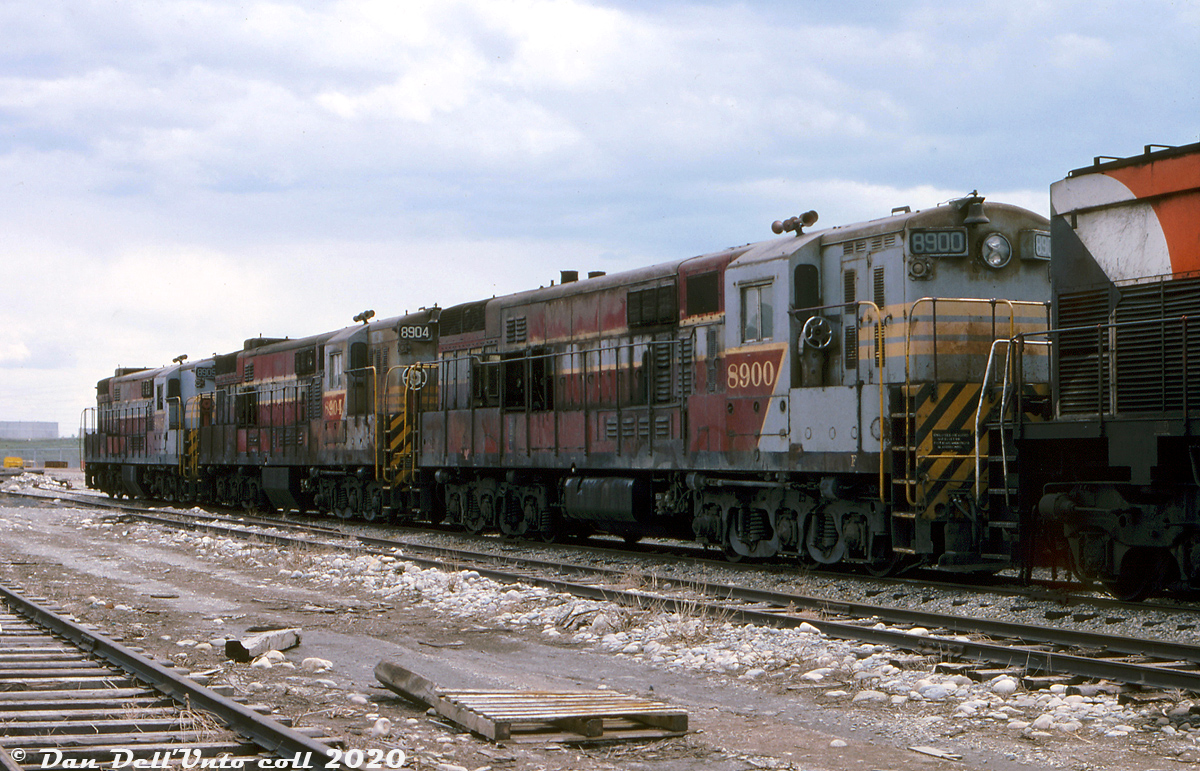|
Caption: A little bit too big, and a little bit before their time: Canadian Pacific's last three Fairbanks Morse/Canadian Locomotive Company H24-66 "Train Master" units, 8900, 8904 and 8905, have reached the end of the line and sit tied up at Ogden Shops, awaiting the green light for the scrapper's torch. These ragged, aging 2400-horsepower beasts were the biggest of the big in the mid-50's and part of 21 that CP originally owned. They had last worked hump duties at the nearby Alyth Yard, each paired with a chop-nosed GP9 (and before that, were assigned to Trail BC to work the steep Warfield Hill leading to the Cominco smelter). At this point, all of their sister 6-axle units had been retired and scrapped starting in the mid-60's.
8900 is notable as it was the first unit built for CP, jointly by FM in the US and finished at CLC in Kingston (all later units were built by CLC). It was originally outfitted with a single steam generator for dual freight/passenger service. 8904 was the final survivor of 4 units (8901-8904) delivered with two steam generators housed in a full-width short hood for passenger service (all removed and hoods narrowed once the passenger trains they worked in Saskatchewan and Manitoba were discontinued in 1960). And 8905 was the first of the standard production freight units built (8905-8920).
Into the 1970's, CP still had a healthy fleet of 4-axle FM/CLC units assigned in the west to Nelson and Alyth, including C-Liners and smaller H16-44 units, but rising maintenance costs and a traffic downturn in 1975 spelled the end for CP's FM/CLC fleet, and they were rounded up en masse that year for scrapping. Their opposed-piston engines weren't really the best suited for railroading conditions, but their popularity and reputation in the marine industry gave railroads an easy client to sell the engines out of scrapped units to.
The trio pictured here managed to survive a bit longer in hump service, until they were rounded up in December 1975 to be stored serviceable (due to their excessive exhaust fumes getting sucked into the yard office ventilation system when they idled nearby). GP7/9 and B-units replaced them on the hump jobs.
After a few months, all three were noted as tied up unserviceable effective May 10th 1976, and the authorization was given to scrap them not long after. Units 8900 and 8904 were cut up for scrap at Ogden Shops in August of 1976, but 8905 was set aside for historical purposes and later donated to the Canadian Railway Museum (Exporail) in Delson QC. It remains the last intact FM/CLC Train Master in existence.
Original photographer unknown, Dan Dell'Unto collection slide.
|



Thank you, CPR for having the historic incentive to preserve one of the great FM Trainmasters. What a pity, none were saved in the USA, though many were available. Great locomotives, albeit difficult to maintain. They are sorely missed.
This is fascinating. Back in the days of poor communication (and you guys know how bad that was!) I was heading west; in 1976; and was told that the chance was good a Trainmaster could be found working around the smelters at Trail BC. I came away with only photos of the facility from up high along the highway. Never did find a locomotive of this type. Well, now I know why. Probably at Ogden by the time I went west in September of 1976.
Congratulations Dan on another outstanding caption to go with a very interesting picture.
I will just add that the brake wheel close to the engineer’s front window of CP 8900 is an artifact from its origin as a long-hood-forward unit (as its siblings built with full-width short hoods needed to be, before getting standard hoods).
CP’s directional colour schemes and usually-visible “F” make it easy to know the front.
PRR5406: a lot of old first generation stuff got cut up back in the 60′s and into the 70′s, as EMD, Alco and GE all took old units as trade-in credit (and salvaged things such as trucks, traction motors, and other components for reuse). The FM units were valuable for their GE traction motors (that could be reused) and opposed-piston engines (popular in marine use).
Almost all of the old units EMD took back were cut up by Pielet Brothers nearby (word is EMD didn’t resell any old units they received, and only a few were lucky to escape to museums). GE did rebuild and resell a number of old units traded in to them, including Alcos and older GE units.